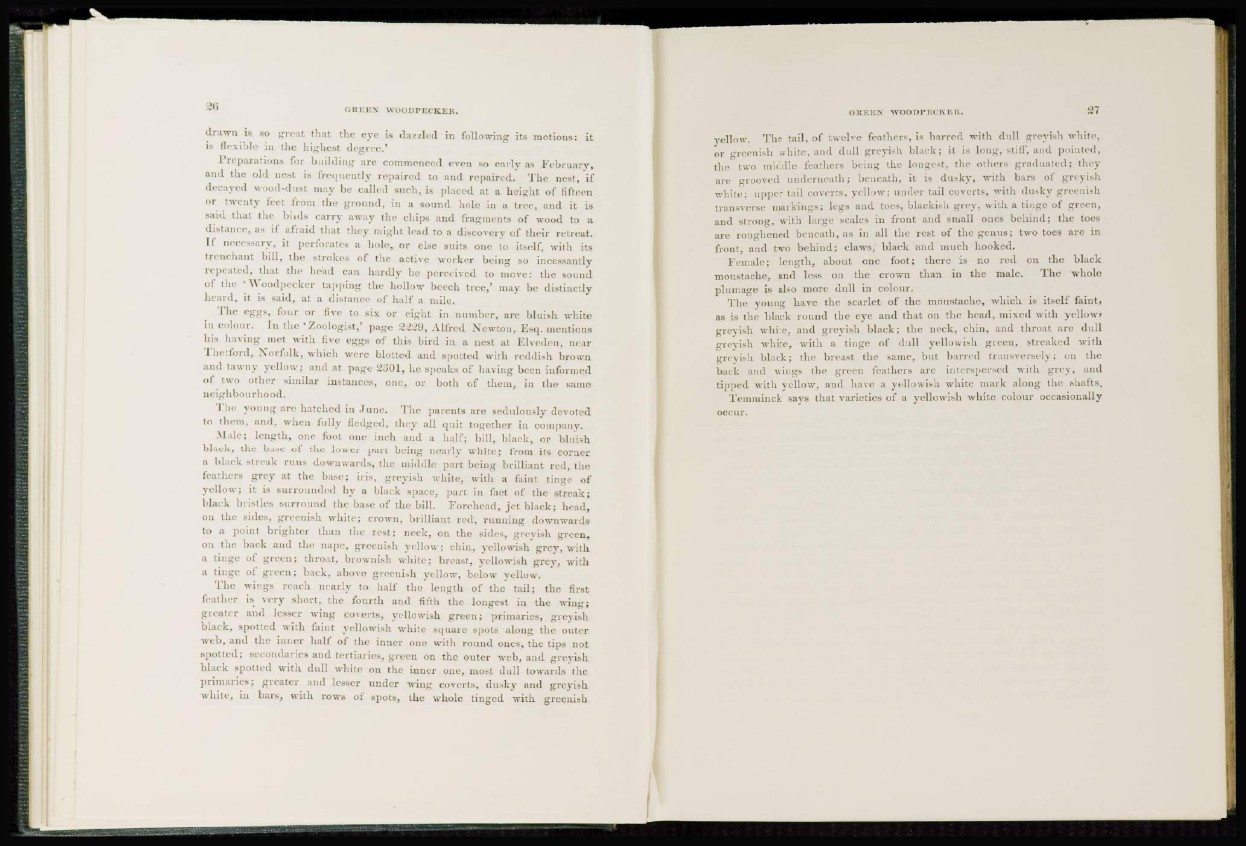
G!! E EM W O O D P E C K E R.
drawn is so great that the eye is dazzled in following its motions: it
is flexible in the highest degree.*
Preparations for building are commenced oven so early as February,
and the old neat is frequently repaired to and repaired. The nest, if
decayed wood-dutt may be called such, is placed at a height of fifteen
or twenty feet from tin' ground, in a sound hole in a tree, and it is
said that the biids carry away the chips and fragments of wood to a
distance, as if afraid that they might lead to a discovery of their retreat.
If necessary, it perforates a hole, or else suits one to itself, with its
trenchant hill, the strokes of the active worker being so incessantly
repeated, that the head can hardly he perceived to move: the sound
of the 'Woodpecker tapping the hollow beech tree,' may be distinctly
heard, it is said, at a distance of half a mile.
The eggs, four or live to six or eight in number, are bluish white
in colour. In the 'Zoologist,' page ££29, Alfred Xewton, Esq. mentions
his having met with five eggs of this bird in a nest at Elveden, near
Thetford, Norfolk, which were blotted and spotted with reddish brown
and tawny yellow; and at page 2301, he speaks of having been informed
of two other similar instances, one, or both of them, in the same
neighbourhood.
The young are hatched in June. The parents are sedulously devoted
to them, and, when fully fledged, they all quit together in company.
Male; length, one foot one inch and a half; bill, black, or bluish
black, the base of the lower part being nearly white; from its corner
a black streak runs downwards, the middle part being brilliant red, the
feathers grey at the base; iris, greyish white, with a faint tinge of
yellow; it is surrounded by a black space, part in fact, of the streak;
black bristles surround the base of the bill. Forehead, jet black; head,
on the sides, greenish white; crown, brilliant red, running downwards
to a point brighter than the rest; neck, on the sides, greyish green,
on the back and the nape, greenish yellow; chin, yellowish grey, with
a tinge of green; throat, brownish white; breast, yellowish grey, with
a tinge of green; back, above greenish yellow, below yellow.
The wings reach nearly to half the length of the tail; the first
feather is very short, the fourth and fifth the longest in the wing;
greater and lesser wing coverts, yellowish green; primaries, greyish
black, spotted with faint yellowish "white square spots along the outer
web, and the inner half of the inner one with round ones, the tips not
spoiled; secondaries and tertiaries, green on the outer web, and greyish
black spotted with dull wdiite on the inner one, most dull towards the
primaries; greater and lesser under wing coverts, dusky and greyish
white, in bars, with rows of spots, the whole tinged with greenish
G E E E J X WOO D P ECK E R . 27
yellow. The tail, of twelve feathers, is barred with dull grevish white,
or greenish white, and dull greyish black; it is long, stiff, and pointed,
the two middle feathers being the longest, the others graduated; they
are grooved underneath; beneath, it is dusky, with bars of grevish
white; upper tail coverts, yellow; under tail coverts, with dusky greenish
transverse markings; legs and toes, blackish grey, with a tinge of green,
and strong, with large scales in front and small ones behind; the toes
are roughened beneath, as in all the rest of the genus; two toes arc in
front, and two behind; claws, black and much hooked.
Female; length, about one foot; there is no red on the black
moustache, and less on the crown than in the male. The whole
plumage is also more dull in colour.
The young have the scarlet of the moustache, which is itself faint,
as is the black round the eye and that on the head, mixed with yellow*
greyish wdiite, and greyish black; the neck, chin, and throat arc dull
greyish white, with a tinge of dull yellowish green, streaked with
greyish black; the breast the same, but barred transversely; on the
back and wings the green feathers are interspersed with grey, and
tipped with yellow, and have a yellowish white mark along the shafts.
Temminck says that varieties of a yellowish white colour occasionally
occur.